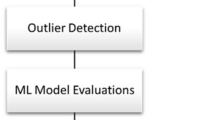Abstract
PATTERN recognition techniques provide one way of uniting quantitative and descriptive geologic data for mineral prospecting. A quantified decision process using computer-selected patterns of geologic data has the potential of selecting areas with undiscovered deposits of uranium or other minerals. When a natural resource is mined more rapidly than it is discovered, its continued production becomes increasingly difficult. For example, Lieberman1 has noted that, although a considerable uranium reserve may remain in the U.S.A., the discovery rate for uranium is decreasing exponentially with cumulative exploration footage drilled. Pattern recognition methods of organising geologic information for prospecting may provide new predictive power as well as insight into the occurrence of uranium ore deposits. Often the task of prospecting consists of three stages of information processing: (1) collection of data on known ore deposits; (2) noting any regularities common to the known examples of an ore; (3) selection of new exploration targets based on the results of the second stage. Here we describe a logical pattern recognition algorithm that implements this geologic procedure to demonstrate the possibility of building a quantified uranium prospecting guide from diverse geologic data.
This is a preview of subscription content, access via your institution
Access options
Subscribe to this journal
Receive 51 print issues and online access
$199.00 per year
only $3.90 per issue
Buy this article
- Purchase on Springer Link
- Instant access to full article PDF
Prices may be subject to local taxes which are calculated during checkout
Similar content being viewed by others
References
Lieberman, M. A. Science 192, 431–434 (1976).
Williams, P. L. U.S.G.S.Map i–360 (1964).
Hostetler, P. B. & Garrels, R. M. Econ. Geol. 57, 137–146 (1962).
Gelfand, I. M., Guberman, Sh. A., Keilis-Borok, V. I., Knopoff, L., Press, F., Ranzman, E. Ya., Rotwain, I. M. & Sadovsky, A. M. Phys. Earth planet. Intn 11, 227–283 (1976).
Briggs, P. L., Press, F. & Sh. A. Guberman Bull. Geol. Soc. Am. 88, 161–173 (1977).
Author information
Authors and Affiliations
Rights and permissions
About this article
Cite this article
BRIGGS, P., PRESS, F. Pattern recognition applied to uranium prospecting. Nature 268, 125–127 (1977). https://doi.org/10.1038/268125a0
Received:
Accepted:
Issue Date:
DOI: https://doi.org/10.1038/268125a0
This article is cited by
-
The field test confirms the prognosis of the location of giant oil and gas fields in the Andes of South America made in 1986
Journal of Petroleum Exploration and Production Technology (2019)
Comments
By submitting a comment you agree to abide by our Terms and Community Guidelines. If you find something abusive or that does not comply with our terms or guidelines please flag it as inappropriate.



